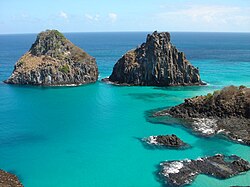Accretion and erosion
Sudden and rapid processes
Tsunamis and hurricane-driven storm surges

Tsunamis can cause significant erosion and sediment displacement. They can strip away years of accumulated sand from beaches and devastate coastal vegetation. These powerful waves can flood inland areas far beyond the typical high-tide mark. Additionally, the swift currents associated with the inundating tsunami can demolish homes and other coastal structures.
A storm surge is an onshore gush of water associated with a low pressure weather system. Storm surges can cause beach accretion and erosion. [1] Historically notable storm surges occurred during the North Sea Flood of 1953, Hurricane Katrina, and the 1970 Bhola cyclone.
Volcanism and earthquakes related sea-level changes
Both geological events and the climate can change (progressively or suddenly) the relative height of the Earth's surface to the sea-level. These events or processes continuously change coastlines.


Volcanic activity can create new islands. For example, Surtsey Island in Iceland which has a diameter of 800 meters (2,600 ft), was created between November 1963 and June 1967. [2] The island emerged from undersea vents that are part of the Vestmannaeyjar submarine volcanic system. [3] Although the island has since partially eroded, but it is expected to last another 100 years.
Some earthquakes can create sudden variations of relative ground level and change the coastline dramatically. Structurally controlled coasts include the San Andreas Fault zone in California and the seismic Mediterranean belt (from Gibraltar to Greece).
The Bay of Pozzuoli, in Pozzuoli, Italy experienced hundreds of tremors between August 1982 and December 1984. The tremors, which reached a peak on October 4, 1983, damaged 8,000 buildings in the city center and raised the sea bottom by almost 2 meters (6.6 ft). This rendered the Bay of Pozzuoli too shallow for large craft and required the reconstruction of the harbor with new quays. The photo at the upper right shows the harbor before the uplift while the one on the bottom right shows the new quay.
Gradual processes
The gradual evolution of beaches often comes from the interaction of longshore drift, a wave-driven process by which sediments move along a beach shore, and other sources of erosion or accretion, such as nearby rivers. [4]
Deltas
Deltas are nourished by alluvial systems and accumulate sand and silt, growing where the sediment flux from land is large enough to avoid complete removal by coastal currents, tides, or waves.
Most modern deltas are formed during the last five thousand years, after the present sea-level high stand was attained. However, not all sediment remains permanently in place: in the short term (decades to centuries), exceptional river floods, storms or other energetic events may remove significant portions of delta sediment or change its lobe distribution (pattern in which sediments are deposited across Delta, forming distinct, lobe shaped structures) and, on longer geological time scales, sea-level fluctuations lead to the destruction of deltaic features.
Subsidence and uplift related sea-level changes
Subsidence is the motion of the Earth's surface downward relative to the sea level due to internal geodynamic causes, It can occur naturally or due to human activities. The opposite of subsidence is uplift, which increases elevation.

Venice is probably the best-known example of a subsiding location. Built suspended over a coastal lagoon, it experiences periodic flooding when extreme high tides or surges arrive; St Mark's Square is built only 55 centimeters above sea level. [5] This phenomenon is caused by the compaction of young sediments in the Po River delta area, magnified by subsurface water and gas exploitation. Man-made works to solve this progressive sinking have been unsuccessful.
Mälaren, the third-largest lake in Sweden, is an example of deglacial uplift. It was once a bay on which seagoing vessels were once able to sail far into the country's interior, but it ultimately became a lake. Its uplift was caused by deglaciation: the removal of the weight of ice-age glaciers caused rapid uplift of the depressed land. For 2,000 years as the ice was unloaded, uplift proceeded at about 7.5 centimeters (3.0 in)/year. Once deglaciation was complete, uplift slowed to about 2.5 centimeters (0.98 in) annually, and it decreased exponentially after that. Today, annual uplift rates are 1 centimeter (0.39 in) or less, and studies suggest that rebound will continue for about another 10,000 years. The total uplift from the end of deglaciation may be up to 400 meters (1,300 ft).































